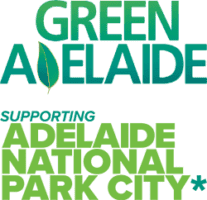Places to Go
Kaurna Country
Connecting with culture through nature
‘Country is my mother’, Kauwanu Tamaru, Kaurna/Narrunga Elder.
No matter where you travel in Australia, the places you visit have always been, and always will be, Aboriginal Country.
We’re sharing seven of our favourite places to visit on Kaurna Country in metropolitan Adelaide to learn about the history of the Country you live on, deepen your understanding of local areas, connect with Traditional Owners, and discover the ancient stories intertwined with the land, sky, waters, plants, and animals.
From national parks to neighbourhood reserves, interpretive trails, artworks, wildlife, waterfalls, nature play and adventure playgrounds, there are options to suit everyone.
We encourage you to visit during the various Kaurna seasons—Warltati (Jan-Mar), Parnati (Apr-Jun), Kudila (Jul-Sep) and Wirltuti (Oct-Dec)—for different seasonal and cultural perspectives.
1. GLENTHORNE NATIONAL PARK-ITYAMAIITPINNA YARTA
Immerse yourself in Aboriginal history, language and culture at Glenthorne National Park-Ityamaiitpinna Yarta. Ityamaiitpinna was a significant Kaurna elder at the time of colonisation. He worked closely with German missionaries to record the Kaurna language. You’ll find interpretive signage, carvings and sculptures, and can learn from Kaurna educator, Jack Buckskin, on the interactive Walking with Winaityinaityi (birds) trail.
Location: Majors Road, O’Halloran Hill (17km south of Adelaide)
Facilities: BBQs, toilets, picnic areas, shelters
Accessibility: accessible toilet, walking trails, car parks (located near the playground) and play equipment
Other things to do: The park features one of the largest nature play spaces in South Australia. Kids will love the adventure playground with its slides (various abilities), flying fox, rope and log climbing, pendulum swing and accessible equipment.
Further information: Download the SA National Parks Tours app to access the Walking with Winaityinaityi tour. It offers a fun way to learn about the winaityinaityi of the park, including their Kaurna names.
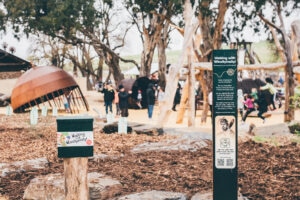
GLENTHORNE NATIONAL PARK-ITYAMAIITPINNA YARTA
2. RIVER TORRENS/KARRAWIRRA PARI (RED GUM FOREST RIVER)
Karrawirra Pari, meaning Red Gum Forest River, is a significant Kaurna cultural site stretching from the Mount Lofty Ranges to West Beach. In Highbury, you’ll find the 1.2km Reconciliation River Walk loop walk along the river. Elders Kauwanu Tamaru, Uncle Frank Wangutya Wanganeen, and Ivan-Tiwu Waritya Copley share their knowledge of the local plants, animals, medicine, and shelters via QR codes on wooden markers along the trail.
Location: Start at the bridge opposite 50 The Promenade, Highbury on Linear Park. (15km northeast of Adelaide)
Facilities: toilets, picnic areas, shelters, playground
Accessibility: Some markers are located off the path on the grass. There are bridges with wooden planks and steep inclines on the western side.
Other things to do: River Torrens Linear Park runs along both sides of Karrawirra Pari from Athelstone to West Beach. The trail offers opportunities to walk or ride, with numerous playgrounds and picnic spots available.
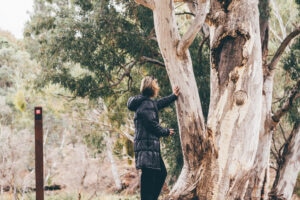
RIVER TORRENS/KARRAWIRRA PARI (RED GUM FOREST RIVER)
3. WARRIPARINGA
Warriparinga is an important Kaurna heritage and ceremonial site. Enter the reserve through the Tjilbruke Gateway, an art installation that offers insights into the Tjilbruke Dreaming story. You’ll find interpretive signage that explains the site’s cultural significance, as well as a scar tree and wardli shelters. The site is also home to the Living Kaurna Cultural Centre.
Location: Sturt Rd, Bedford Park (12km south of Adelaide)
Facilities: toilets, seating and shady areas
Other things to do: Warraparinga Wetlands are home to over 30 bird species, with plenty of space to wander, sit and observe the plants and animals. You can walk or ride your bike around the wetlands and connecting Sturt River Linear Park Trail.
4. MORIALTA CONSERVATION PARK
Morialta Conservation Park is a sacred men’s site and was once an important place for the Kaurna people to shelter and find food during winter. ‘Morialta’ is the Kaurna name for the area and means ‘ever-flowing’. Before your visit, learn more about the creator-giant Nganno. See if his profile is revealed amongst the rocks and feel the peace in his wardli (shelter/home), known as Giant’s Cave, on a family friendly hike to First Falls.
Location: Stradbroke Rd, Woodforde (10km northeast of Adelaide)
Facilities: Parking, toilets, BBQs, shaded tables and benches available
Accessibility: Accessible car parks are located at the Stradbroke Rd parking area. There are two accessible toilets located near Mukanthi nature playground.
Other things to do: There are creeks, gorges, waterfalls and hiking trails to explore. Take a walk, listen for frogs, spot wildlife like kangaroos and koalas, enjoy a picnic, or play on Mukanthi nature playground. Mukanthi means ‘play’ or ‘celebrate’ in Kaurna.
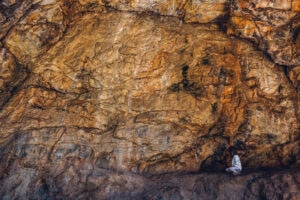
GIANT’S CAVE, MORIALTA CONSERVATION PARK
5. FELIXSTOW RESERVE
Follow the Kaurna Interpretive Trail to learn about the cultural and spiritual significance of the area for the Kaurna people. You’ll find cultural markers and language signs offering insights into traditional practices, local plants and animals, the Kaurna seasons and a rare and significant canoe scar tree over 200 years old. The cultural markers were brought to life by Paul Herzich, Kaurna/Ngarrindjeri Landscape Architect and Public Artist.
Location: Langman Grove, Felixstow (7km east of Adelaide)
Facilities: BBQ, toilets, basketball court, seating and shady areas for picnics.
Other things to do: There are walking trails and nature play opportunities including wardli shelters to explore. You’ll also find plenty of wildlife in the wetlands.
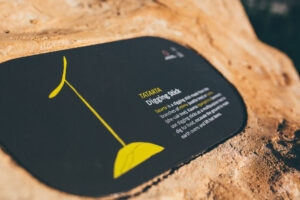
FELIXSTOW RESERVE
6. BREAKOUT CREEK/PURRUNA PARI
Explore the recently redeveloped western section of the River Torrens/Karrawirra Pari, where you’ll find a flourishing and more accessible community green space with boardwalks, viewing decks, and picnic areas. Breakout Creek/Purruna Pari is an ideal place to reflect on Kaurna history and cultural practices, with nine Kaurna artworks created by Allan Sumner, Ngarrindjeri/Kaurna artist, featured along the riverbank.
Location: Seaview Road, West Beach (8km west of Adelaide). To view the artworks, we suggest parking near the Kaurna Reflection Space off Military Rd, Henley Beach South.
Facilities: Picnic areas and shelters. You’ll find BBQ facilities, playground and toilet at nearby Apex Park.
Accessibility: Asphalt paths
Other things to do: New elevated boardwalks link Linear Park to nearby Apex Park, offering plenty of nature play and outdoor activities.
7. TARNDANYA/ADELAIDE
Tarndanya means place of the Red Kangaroo and covers the area we now call Adelaide. The Kaurna Walking Trail, created by the Graham F Smith Peace Foundation, starts at the Kaurna Reconciliation Sculpture in front of the Adelaide Festival Centre. This (approx.) 10km trail takes you to 17 cultural and heritage sites, with an online interactive trail map providing directions, as well as information on the significance of each location.
Location: Tarndanya/Adelaide CBD
Accessibility: Mostly paved, suitable for walking, prams and bikes.
Other things to do: Adelaide Oval, Elder Park, the State Library of South Australia, Art Gallery of South Australia and South Australian Museum are within walking distance and offer additional learning opportunities.
Further information: The Kaurna Voices: Cultural Mapping of the Adelaide Park Lands developed by the Kaurna Yerta Aboriginal Corporation and the City of Adelaide is an additional resource that explores Kaurna people’s sacred connections to the land.
- Explore Aboriginal-led tours, experiences, and events, including annual Festivals that showcase Aboriginal cultural experiences.
- Visit National Parks co-managed by Traditional Owners and delve into key Parks rich with Aboriginal cultural heritage.
- Discover the Aboriginal names and uses for local plants and animals, and use them when enjoying nature.
- Engage Aboriginal people to share stories or conduct cultural workshops at your workplace or school.
- Find a sit spot under an old tree in your neighbourhood and read a book by an Aboriginal author. If you need help finding a title, take a look at Magabala—Australia’s leading Aboriginal publishing house.
Look out for our upcoming nature walks, often led side-by-side with Aboriginal Elders and Traditional Owners.



